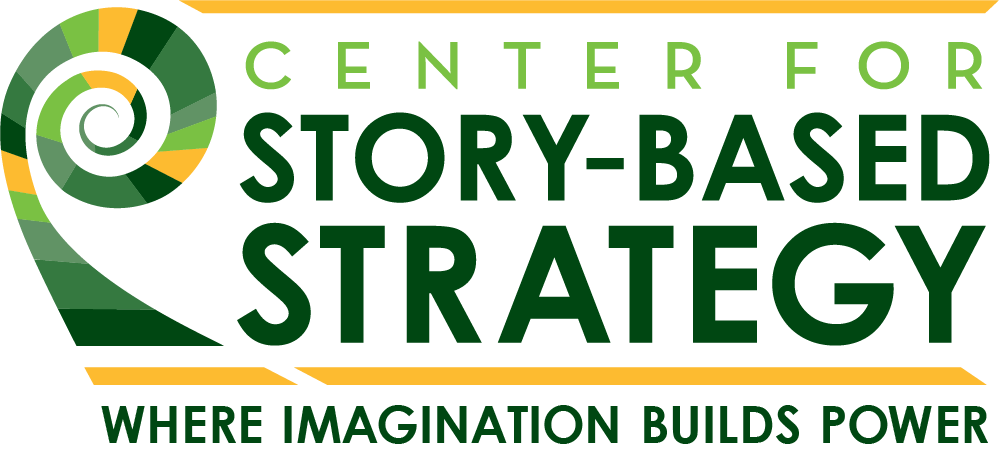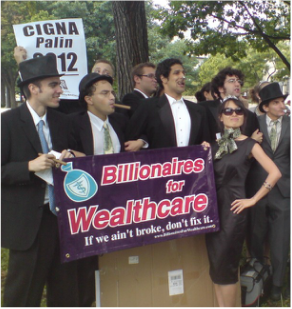The billionaires are back!
ONE OF OUR FAVORITE MEME CAMPAIGNS RETURNS!
Long time Billionaire street activist Phil T. Rich is returning to another election cycle with an appeal to the .0001% to unite in “ruling class solidarity”. Apparently, he and others benefactors of America’s excessive inequality can no longer ignore the growing momentum of economic populist Bernie Sanders presidential campaign.
As he writes in his open letter announcing the creation of the new Billionaires Against Bernie SuperPAC:
Our good colleagues at Goldman Sachs have called him a “dangerous” threat, and I agree. I have begun to Fear the Bern, and I enjoin you all to Fear the Bern with me.
For those unfamiliar with the guerilla joys of protesting oligarchs let us provide a little historical context. The Billionaires have been one of the most enjoyable, flexible and effective meme campaigns of the last two decades. The campaign was originally created in the lead up to the 2000 elections, when economic justice activists promoting campaign finance reform, set out to expose the undue influence of big money contributors on both parties. They created Billionaires for Bush (or Gore), a faux movement of Billionaires. They took on billionaire personas like Phil T. Rich and Hallie Burton who would stage media-savy protests with messages like “Widen the income gap” and “Tax the poor, not us!” They even staged a Million Billionaire march. Grassroots activists around the country jumped on board and the media loved it.
Billionaires for Bush (or Gore) was essentially a street theater concept to transmit a specific meme: Big Money ownes both candidates. The organizers provided some basic resources—core messages, costuming tips, and adaptable guerilla theater scenarios that would allow the meme to spread virally without losing its core meaning. The oxymoron of Billionaires protesting, as well as the “Bush OR Gore” tagline, was so at odds with the conventional framing of the election that it captured the attention of people and the media. The campaign itself was particularly effective because it was accessible: anyone could become a Billionaire. Activists around the country tailored the tactic to their own needs throughout the election, and spread the meme with in-character radio spots, protests, and stunts at candidate events—delivering a hard-hitting political message with humor. For a thorough description and analysis of the campaign read Billionaires co-founder Andrew Boyd’s essay “Truth is a Virus: Meme Warfare and the Billionaires for Bush (or Gore)” published in the Cultural Resistance Reader edited by Stephen Duncombe (Verso, 2002) or checked out the case study on in the Beautiful Trouble online toolbox.
Over the past decade and a half, the Billionaires meme has resurfaced in newly adapted forms repeatedly, all the while using humor and storytelling to mobilize thousands of people and attract lots of media attention. In 2004 they were back as Billionaires for Bush, with slogans like “Four More Wars” and “Leave No Billionaire Behind.” Later the Billionaires meme morphed into other campaigns like Billionaires for Big Oil, Billionaires for Wealthcare NOT Healthcare and other timely interventions into political debates.
Now the meme campaign has evolved again and with the new Billionaires Against Bernice SuperPAC anyone can get in on the fun. Just check out the Billionaire starter kit, which includes everything from character naming tips to sample press releases.
The term “meme campaigning,” as far as we know, was coined by longtime creative activist and Billionaire co-creator Andrew Boyd. Although when we asked him about the origins of the terms back in 2008, Andrew, charming and humble man that he is, put it this way: “you can call me a co-coiner of the phrase along with a host of others in the secret people's history of viral organizing...”
At CSS we train organizers to utilize a narrative power analysis in their campaigns and often times work with them to design a core meme or two that will “encapsulate” the campaigns core messages. But beyond just creating effective messaging, thinking of campaigns in terms of memes opens up new possibilities and opportunities for organizing. A key part of organizing is about creating the structures to facilitate people taking action and building collective power. Thus the right, well-designed meme can act as a viral organizing container and facilitate self-organizing. The center of a meme campaign is not the headquarters or campaign leadership, and the goal is usually not building organizational membership in the traditional sense. Instead, the campaign is a shared narrative and the contagious, self-replicating meme that spreads that larger story. A good meme campaign is designed so that people can take the meme and “run with it” at the grassroots level without the meme losing its intent and core message. When the right meme captures the political moment and combines with effective decentralized organizing (and a bit of luck) it can shift debates and mobilize millions. This is the underlying logic that turns a hashtag into a mobilization whether its Occupy Wall Street and the 99% meme or the ongoing movement building and deep cultural intervention of #BlackLivesMatter.
The many lives of the Billionaires meme shows how an effective meme campaign can provide an opportunity to carry an issue beyond geographic or budgetary limitations.
It also shows that in the rights hands, humor is a powerful weapon, particularly when it’s packaged into a powerful meme and a creative intervention strategy that can propel it into public attention.
So welcome back Billionaires! We’ll see you in the streets because as it says in the Billionaires Call to action the “wealth ain’t going to protect itself”.




